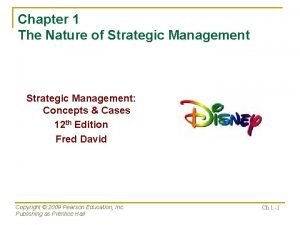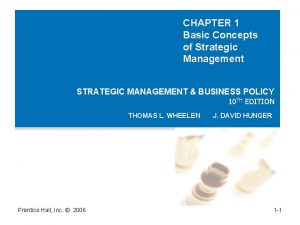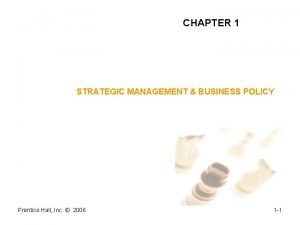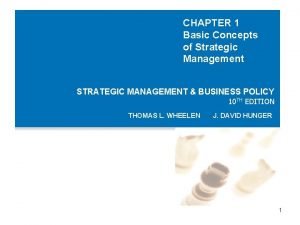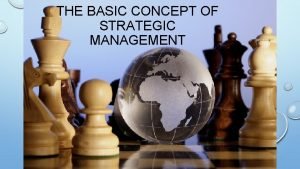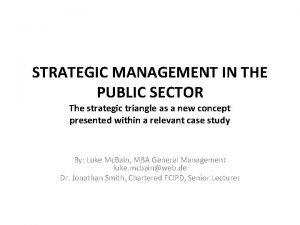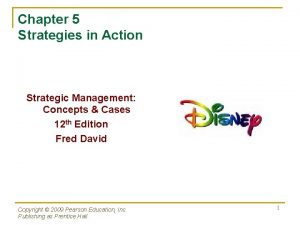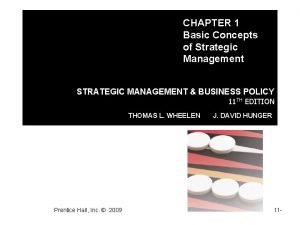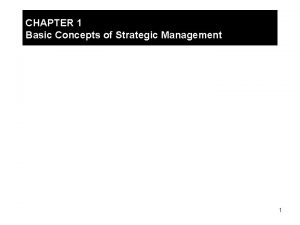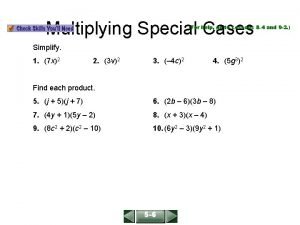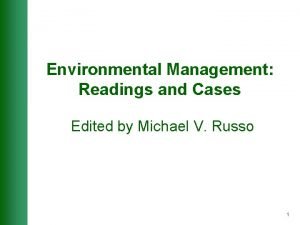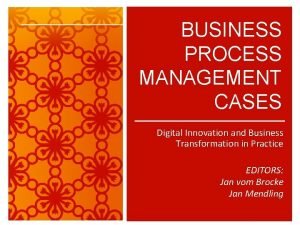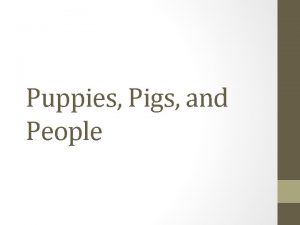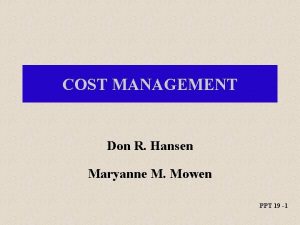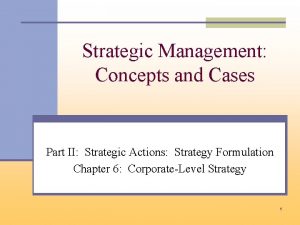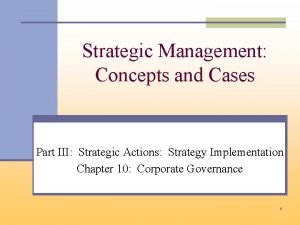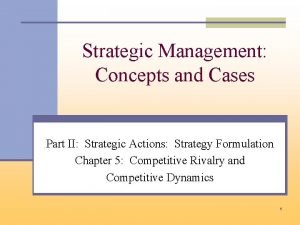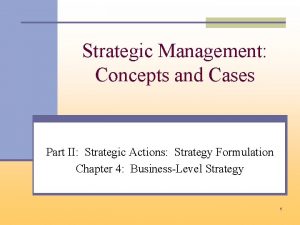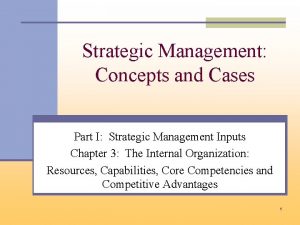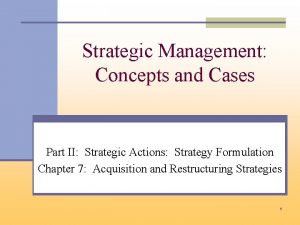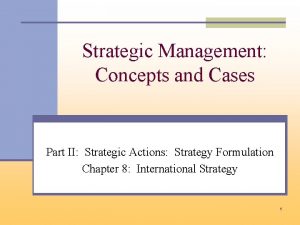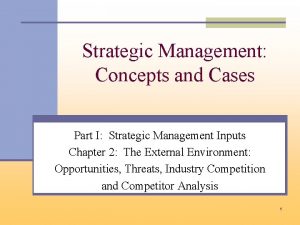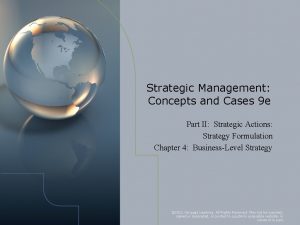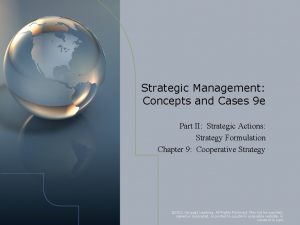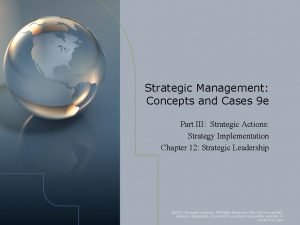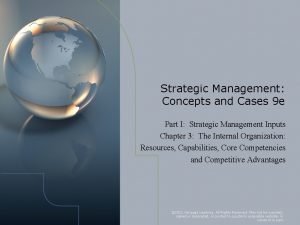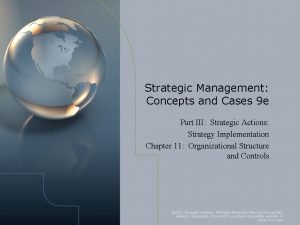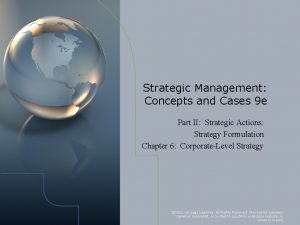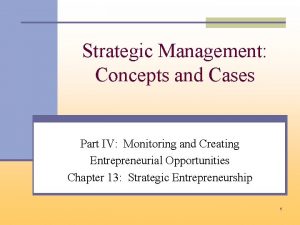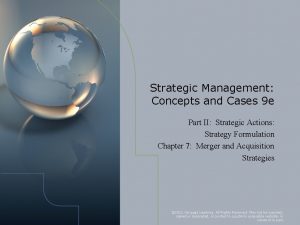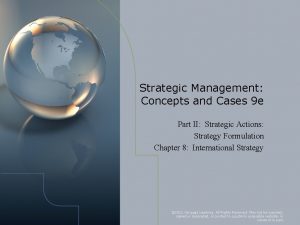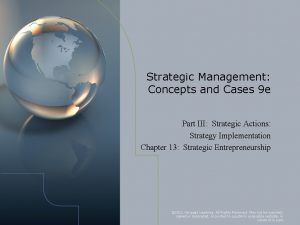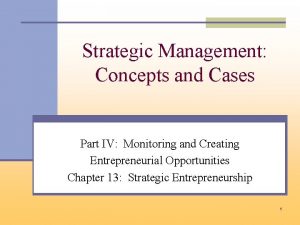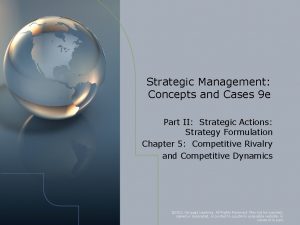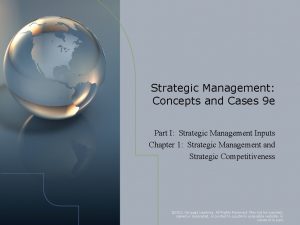Strategic Management Concepts and Cases 9 e Part





























- Slides: 29

Strategic Management: Concepts and Cases 9 e Part I: Strategic Management Inputs Chapter 2: The External Environment: Opportunities, Threats, Industry Competition and Competitor Analysis © 2011 Cengage Learning. All Rights Reserved. May not be scanned, copied or duplicated, or posted to a publicly accessible website, in whole or in part.

The Strategic Management Process © 2011 Cengage Learning. All Rights Reserved. May not be scanned, copied or duplicated, or posted to a publicly accessible website, in whole or in part.

Chapter 2: The External Environment: Opportunities, Threats, Industry Competition and Competitor Analysis • Overview: Seven content areas – The firm’s external environment – General and industry environment – External environment analysis process activities – General environment segments – Porter’s 5 Competitive Forces – Strategic groups: Definition and influence – Competitor Analysis: Intelligence and ethics © 2011 Cengage Learning. All Rights Reserved. May not be scanned, copied or duplicated, or posted to a publicly accessible website, in whole or in part.

Effects of External Environment: Philip Morris International (PMI) • Largest international market share and leading company in 11 of top 30 cigarette markets • Implementing strategies in anticipation of future external environmental conditions – Working with foreign governments on regulatory framework – Opportunities in emerging markets – Smokeless tobacco in anticipation of fewer smokers – Support of sustainable farming – Waste reduction in manufacturing © 2011 Cengage Learning. All Rights Reserved. May not be scanned, copied or duplicated, or posted to a publicly accessible website, in whole or in part.

Chapter 2: The External Environment: Opportunities, Threats, Industry Competition and Competitor Analysis • Overview: Seven content areas – The firm’s external environment – General and industry environment – External environment analysis process activities – General environment segments – Porter’s 5 Competitive Forces – Strategic groups: Definition and influence – Competitor Analysis: Intelligence and ethics © 2011 Cengage Learning. All Rights Reserved. May not be scanned, copied or duplicated, or posted to a publicly accessible website, in whole or in part.

External Environment: General, Industry and Competitor • Three External Environments include: – General – Industry – Competitor © 2011 Cengage Learning. All Rights Reserved. May not be scanned, copied or duplicated, or posted to a publicly accessible website, in whole or in part.

External Environment: General, Industry and Competitor (Cont’d) • The General Environment – The broader society dimensions that influence an industry and the firms within it – Grouped into 7 dimensions OR ‘environmental segments’ Each segment composed of elements © 2011 Cengage Learning. All Rights Reserved. May not be scanned, copied or duplicated, or posted to a publicly accessible website, in whole or in part.

The External Environment © 2011 Cengage Learning. All Rights Reserved. May not be scanned, copied or duplicated, or posted to a publicly accessible website, in whole or in part.

External Environment: General, Industry and Competitor (Cont’d) • Industry Environment – Set of factors directly influencing • A firm’s competitive actions/responses • Relates to Porter’s 5 Forces – see upcoming slides • Competitor analysis: gather and interpret competitor information • Competitor Environment – Gives details about • A firm’s direct and indirect competitors • The competitive dynamics expected to impact a firm's efforts to generate above-average returns © 2011 Cengage Learning. All Rights Reserved. May not be scanned, copied or duplicated, or posted to a publicly accessible website, in whole or in part.

Chapter 2: The External Environment: Opportunities, Threats, Industry Competition and Competitor Analysis • Overview: Seven content areas – The firm’s external environment – General and industry environment – External environment analysis process activities – General environment segments – Porter’s 5 Competitive Forces – Strategic groups: Definition and influence – Competitor Analysis: Intelligence and ethics © 2011 Cengage Learning. All Rights Reserved. May not be scanned, copied or duplicated, or posted to a publicly accessible website, in whole or in part.

External Environment Analysis • Opportunity – General environment condition that, if exploited, helps a company achieve strategic competitiveness • Threat – General environment condition that may hinder a company's efforts to achieve strategic competitiveness © 2011 Cengage Learning. All Rights Reserved. May not be scanned, copied or duplicated, or posted to a publicly accessible website, in whole or in part.

External Environment Analysis (Cont’d) • 4 components of External Environment Analysis – Scanning – Monitoring – Forecasting – Assessing © 2011 Cengage Learning. All Rights Reserved. May not be scanned, copied or duplicated, or posted to a publicly accessible website, in whole or in part.

Chapter 2: The External Environment: Opportunities, Threats, Industry Competition and Competitor Analysis • Overview: Seven content areas – The firm’s external environment – General and industry environment – External environment analysis process activities – General environment segments – Porter’s 5 Competitive Forces – Strategic groups: Definition and influence – Competitor Analysis: Intelligence and ethics © 2011 Cengage Learning. All Rights Reserved. May not be scanned, copied or duplicated, or posted to a publicly accessible website, in whole or in part.

Segments of the General Environment • 7 Segments – Demographic – Economic – Political/Legal – Sociocultural – Technological – Global – Physical Environment © 2011 Cengage Learning. All Rights Reserved. May not be scanned, copied or duplicated, or posted to a publicly accessible website, in whole or in part.

Chapter 2: The External Environment: Opportunities, Threats, Industry Competition and Competitor Analysis • Overview: Seven content areas – The firm’s external environment – General and industry environment – External environment analysis process activities – General environment segments – Porter’s 5 Competitive Forces – Strategic groups: Definition and influence – Competitor Analysis: Intelligence and ethics © 2011 Cengage Learning. All Rights Reserved. May not be scanned, copied or duplicated, or posted to a publicly accessible website, in whole or in part.

Industry Environment Analysis • Industry – Definition: Group of firms producing products that are close substitutes – Industry environment, in comparison to the general environment, has more direct effect of firm’s • Strategic competitiveness and • Above-average returns – Intensity of industry competition and industry’s profit potential are a function of 5 forces (See next slide) © 2011 Cengage Learning. All Rights Reserved. May not be scanned, copied or duplicated, or posted to a publicly accessible website, in whole or in part.

The Five Forces of Competition Model © 2011 Cengage Learning. All Rights Reserved. May not be scanned, copied or duplicated, or posted to a publicly accessible website, in whole or in part.

Industry Environment Analysis (Cont’d) • Porter’s 5 Forces – 1/5: New entrants • Can threaten market share of existing competitors • May bring additional production capacity • Function of two factors – 1: Barriers to entry » Economies of scale » Product differentiation » Capital requirements » Switching costs » Access to distribution channels » Cost disadvantages independent of scale » Gov’t policy – 2: Expected retaliation © 2011 Cengage Learning. All Rights Reserved. May not be scanned, copied or duplicated, or posted to a publicly accessible website, in whole or in part.

Industry Environment Analysis (Cont’d) • Porter’s 5 Forces – 2/5: Bargaining power of suppliers • They are powerful when … – 1. – – 2. – 3. – 4. – 5. – 6. Few large companies and more concentrated than the industry to which they sell No substitutes Industry firms not significant customer to supplier gp Supplier’s goods are critical to buyer’s success High switching costs due to effectiveness of supplier’s products Threat of forward integration © 2011 Cengage Learning. All Rights Reserved. May not be scanned, copied or duplicated, or posted to a publicly accessible website, in whole or in part.

Industry Environment Analysis (Cont’d) • Porter’s 5 Forces – 3/5: Bargaining power of buyers • They are powerful when … – 1. – 2. – 3. – 4. – – Purchase large portion of industry’s total output Product sales accounts for significant seller annual revenue Low switching costs (to other industry product) Industry products are undifferentiated or standardized and threat of backward integration © 2011 Cengage Learning. All Rights Reserved. May not be scanned, copied or duplicated, or posted to a publicly accessible website, in whole or in part.

Industry Environment Analysis (Cont’d) • Porter’s 5 Forces – 4/5: Threat of substitute products • Goods or services outside of given industry perform same or similar functions at a competitive price (i. e. , plastic has replaced steel in many applications) – 5/5: Intensity of Rivalry Among Competitors • Numerous or equally balanced competitors • Slow industry growth • High fixed costs or high storage costs • Lack of differentiation or low switching costs • High strategic stakes • High exit barriers © 2011 Cengage Learning. All Rights Reserved. May not be scanned, copied or duplicated, or posted to a publicly accessible website, in whole or in part.

Industry Environment Analysis (Cont’d) • Porter’s 5 Forces – 5/5: Intensity of Rivalry Among Competitors • High exit barriers (Cont’d) – 1. – 2. – 3. – 4. – 5. – Specialized assets Fixed costs of exit (i. e. , labor agreements) Strategic interrelationships (i. e. , one business depends on another) Emotional barriers (i. e. , loyalty to employees, etc. ) Government and social restrictions © 2011 Cengage Learning. All Rights Reserved. May not be scanned, copied or duplicated, or posted to a publicly accessible website, in whole or in part.

Chapter 2: The External Environment: Opportunities, Threats, Industry Competition and Competitor Analysis • Overview: Seven content areas – The firm’s external environment – General and industry environment – External environment analysis process activities – General environment segments – Porter’s 5 Competitive Forces – Strategic groups: Definition and influence – Competitor Analysis: Intelligence and ethics © 2011 Cengage Learning. All Rights Reserved. May not be scanned, copied or duplicated, or posted to a publicly accessible website, in whole or in part.

Strategic Groups • Strategic Groups – Set of firms emphasizing similar strategic dimensions to use a similar strategy – Implications • Because firms within a group compete (offer similar products) rivalry can be intense – the greater the rivalry the greater the threat to each firm’s profitability • Strengths of the 5 forces differs across strategic groups • The closer the strategic groups, in terms of strategy, the greater the likelihood of rivalry © 2011 Cengage Learning. All Rights Reserved. May not be scanned, copied or duplicated, or posted to a publicly accessible website, in whole or in part.

Chapter 2: The External Environment: Opportunities, Threats, Industry Competition and Competitor Analysis • Overview: Seven content areas – The firm’s external environment – General and industry environment – External environment analysis process activities – General environment segments – Porter’s 5 Competitive Forces – Strategic groups: Definition and influence – Competitor Analysis: Intelligence and ethics © 2011 Cengage Learning. All Rights Reserved. May not be scanned, copied or duplicated, or posted to a publicly accessible website, in whole or in part.

Competitor Analysis • Competitor analysis and organization response: – What drives competitors • Shown by organization's future objectives – What the competitor is doing and can do • Revealed in organization's current strategy – What the competitor believes about the industry • Shown in organization's assumptions – What the competitor’s capabilities are • Shown by organization's strengths and weaknesses © 2011 Cengage Learning. All Rights Reserved. May not be scanned, copied or duplicated, or posted to a publicly accessible website, in whole or in part.

Competitor Analysis Components © 2011 Cengage Learning. All Rights Reserved. May not be scanned, copied or duplicated, or posted to a publicly accessible website, in whole or in part.

Competitor Analysis (Cont’d) • Competitor intelligence – Set of data and information the firm gathers to better understand anticipate competitors' objectives, strategies, assumptions, and capabilities © 2011 Cengage Learning. All Rights Reserved. May not be scanned, copied or duplicated, or posted to a publicly accessible website, in whole or in part.

Intelligence Collection (Cont’d) • Follow ethical practices when gathering competitor intelligence – Obtain public information – Attend trade fairs and shows and collect brochures, view exhibits, listen to their discussions • Some practices may be legal, but unethical • Unethical tactics can include – Blackmail – Trespassing – Eavesdropping – Stealing drawings, samples or documents © 2011 Cengage Learning. All Rights Reserved. May not be scanned, copied or duplicated, or posted to a publicly accessible website, in whole or in part.
 Criminal cases vs civil cases
Criminal cases vs civil cases Strategic management and strategic competitiveness
Strategic management and strategic competitiveness Strategy analysis and choice largely involves making
Strategy analysis and choice largely involves making Business ethics in strategic management
Business ethics in strategic management Basic concepts of strategic management
Basic concepts of strategic management Basic concept of strategic management
Basic concept of strategic management Basic concepts of strategic management
Basic concepts of strategic management Basic concepts of strategic management
Basic concepts of strategic management Strategic management in public sector
Strategic management in public sector Why is not advisable to pursue too many strategies at once
Why is not advisable to pursue too many strategies at once Strategic management decision making process
Strategic management decision making process Basic concepts of strategic management
Basic concepts of strategic management Practice 9-4 multiplying special cases answer key
Practice 9-4 multiplying special cases answer key Strategic complements definition
Strategic complements definition Analyzing transactions in accounting
Analyzing transactions in accounting Environmental management: readings and cases
Environmental management: readings and cases Strategic family therapy concepts
Strategic family therapy concepts Strategic fit vs strategic intent
Strategic fit vs strategic intent Business process management cases
Business process management cases Norcross puppies pigs
Norcross puppies pigs Part whole model subtraction
Part whole model subtraction Part to part ratio definition
Part to part ratio definition Brainpop ratios
Brainpop ratios What is a technical description?
What is a technical description? 5 parts of bar
5 parts of bar The phase of the moon you see depends on ______.
The phase of the moon you see depends on ______. Part to part variation
Part to part variation Masterful strategies come from
Masterful strategies come from Social responsibility and ethics in strategic management
Social responsibility and ethics in strategic management Cost management hansen
Cost management hansen



